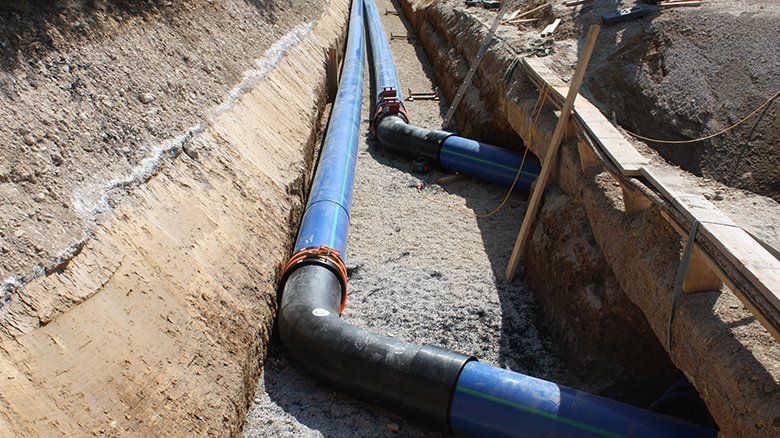Pipe line crosses a motorway by using horizontal directional drilling
Year of installation: 2015
Material: AGRU Sureline (PE 100-RC) with protective layer
Dimension: 560 SDR 17
Medium: Potable Water
Temperature: 15 °C

Year of installation: 2015
Material: AGRU Sureline (PE 100-RC) with protective layer
Dimension: 560 SDR 17
Medium: Potable Water
Temperature: 15 °C
The E-Werk Wels AG decided to build an additional drinking water reservoir in Traunleiten, Austria to be able to ensure the water supply during a renovation of the existing drinking water reservoir. Additionally the drinking water storage capacity is increased and further surrounding communities can be supplied. The project planning was assigned to the planning office Hitzfelder & Pillichshammer following a tendering procedure. The building contractor RBS Rohrleitungsbau decided to use pipes in the dimension OD 560mm for the water transportation from and to the new reservoir. The main challenge of the project represented a crossing of the motorway which could not be avoided. The efficient and cost-saving horizontal directional drilling technique was chosen in order to overcome this obstacle.
The AGRU Sureline® pipe with protective layer in the dimension 560 mm SDR 17 was selected for the horizontal direction drilling installation as well as for the trench installation. This was primarily due to the excellent properties of PE regarding flexibility and low weight as well as the easy and quick welding connection possibilities. The ÖVGW certificated Sureline® pipe is made of high-quality PE 100-RC and is surrounded with a protective layer against scratches made of PP. This special pipe is designed for extreme requirements such as alternative installation techniques like horizontal directional drilling, sandbed-free installation or pipe bursting.
In total 1500 m Sureline® pipes with protective layer were joined by heated tool butt welding.
AGRU sweep bends provide optimal flow characteristics.
After the welding process, the area of the pre- removed protection layer was completely filled by the welding bead which led to a uniform surface for an easy installation.
In order to be able to insert the pipes with protective layer in the dimension of 560 mm underneath the motorway, pilot holes were drilled and extended to a dimension of 750 mm. Next, the construction crew connected the drilling head to the prepared, pre-welded pipes which then helped to draw in the pipe line in the opposite to the drilling direction. A special “drillmix” drilling fluid was used instead of the usual bentonite. Drillmix is a mixture of bentonite and cement which remains and cures in the annular gap of the drill-hole. This measure was necessary due to the high demands caused by the motorway above the line.
The pipes were inserted with a traction force of 25 tons. Under the prevailing conditions AGRU Sureline® pipes with protective layer endure the maximum permissible traction force of 70 tons which means that the pipes offered enough scope of strain.
The team examined the surface of the AGRU Sureline® pipe with protective layer after the installation. Scratches of no more than 1.5 mm depth were found which cause no further problems as the protective layer of the pipe is 3 mm thick. This means that the intactness and operational reliability of the inner PE 100-RC pipe was fully guaranteed.
The remaining pipes were laid through the conventional trench technique. The builders mainly connected the straight sections by the heated tool butt welding. Whereas, some segments were joined by Electro-socket welding using AGRU EF-couplers. The EF-couplers enabled a fast installation due to the bifilar design. The welding areas are separated which allows that the pipes can be pre-welded on one side outside the trench. For changes of direction AGRU sweep bends were built in which have the same pressure ratings as the corresponding pipes and therefore, show improved flow characteristics. Finally, the pipe line and the water reservoir were joined with an AGRU flange connection.


